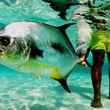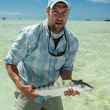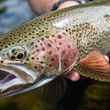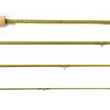I’m so pissed that I have to resort to cliché. And not that idiotic one, “that’s why they call it fishing and not catching,” intended to justify a fruitless day on the water. Hell, these days I’d kill for the chance to step into my homewater and futilely swing flies through a river full of wild steelhead. But unfortunately, that’s not a possibility because when it comes to steelhead management, we’ve gone insane.
Here’s that cliché: they say the definition of insanity is doing the same thing over and over again but expecting different results. Our steelhead management? It’s worse than that. We don’t just do the same thing over and over again, we fight ferociously for the chance to do it.
Let’s take a quick step back. Starting in the 1930s, some elected officials decided to transform sleepy Lewiston, Idaho into a major inland port and transportation epicenter. To make that happen, they had to tame the wild lower Snake River, which was at the time home to perhaps the best steelhead and salmon habitat on the planet. Ice Harbor Dam came online in 1960 followed by Lower Granite Dam in 1975. Today’s Snake River is now a shell of its once great self.
Before development wreaked havoc on Columbia/Snake watershed, that corner of the Pacific Northwest boasted the greatest salmon runs anywhere on the planet. Nowhere in Alaska, British Columbia or Europe came close to matching its productivity. But the ill-fated work of the hands of man turned the world’s leading salmon system into one that is now home to a mere thirteen endangered runs of wild salmon and steelhead.
The listing of these thirteen runs under the Endangered Species Act initiated what is now a twenty-year long recovery effort. As you might have already guessed, these recovery efforts have been less than successful. In fact, after two decades and $16 billion taxpayer dollars, not a single endangered population has recovered. Now, in the midst of a historically dismal year, things just keep looking bleaker.
You would think that in the face of these shrinking returns and escalating costs, federal officials responsible for facilitating recovery would be scrambling for a new approach. Unfortunately, you’d be wrong.. Instead, they have remained steadfast and committed to a failing strategy, one that federal courts have ruled to be insufficient five times.
The most recent of these five rulings came in 2016 when U.S. District Court Judge Michael Simon determined that the federal government’s recovery efforts and approach are woefully insufficient and instructed them to develop a new plan. His biting words that the Federal Columbia River Power System “cries out for a new approach and new thinking” as well as his urging that they consider lower Snake River Dam removal was music to the ears of salmon, steelhead, and river advocates. But for those folks obsessed with maintaining the ever-worsening status quo, Judge Simon’s words must have sounded like nails on a chalkboard.
The irony of this situation is inescapable. When it comes to managing steelhead, we refuse to think differently about how to recover these struggling populations. Yet, when a court rules that we must do just that, creativity abounds and bulbs are lit as we pull out all of the stops to undermine that ruling, ensuring that we can do the same thing time and again—spend billions of dollars on ineffective, speculative habitat mitigation and make minor tweaks to dam operations to "improve" passage for migrating fish.
The manifestation of this creative subterfuge is H.R. 3144, a bill introduced in the U.S. House of Representatives by Congresswoman Cathy McMorris Rodgers. This destructive legislation seeks to overturn two decades of scientifically backed judicial review and multiple federal court orders in order to ensure that the failed efforts of the past will become the failed approaches of our future.
Specifically, the legislation upholds the invalidated 2014 Federal Columbia River Power Systems (FCRPS) Biological Opinion until 2022. Making matters worse, it would also overturn the March 2017 court order to increase spring spill over federal dams on the lower Columbia and Snake rivers. These spills release water over dams and help migrating juvenile salmon reach the ocean quicker and safer, which is currently the most effective short-term solution to improve survival of endangered salmonid populations.
Additionally, the bad bill would eliminate any ability to study the effects of dam removal on the Snake system. This upends the months long process in the fall of 2016 that gave citizens the opportunity to submit their comments on what should be done with the dams. Over 400,000 comments were logged in that submission period that now wouldn’t see the light of day or have any impact. What was and is the public’s shot at having a seat at the table and a voice in choosing a new future would be wiped under the rug of bureaucratic overreach. Run along John and Jane Q Public, your opinion isn’t needed.
After following this fight for years, it still seems impossible to conceive the lengths to which these folks will go to undermine recovery efforts, especially at a time when evidence of the problem is so blatantly apparent. We are in the midst of a historically bad run, quite possibly the worst from a steelhead perspective. Fisheries are closing down and their managers are unable to wrap their head around the scale of the problem.
Yet many are doubling down on our historically failed approach, engaging in an all out public relations war. Efforts to overturn a number of court orders and years of scientifically backed judicial review with legislation continue. They have even approached the Trump Administration and asked them to convene the “God squad”, a cabinet-level committee with the power to sidestep the Endangered Species Act.
It may seem odd, but I find myself hoping that insanity plagues those that continue to fight science and reason. The alternative—that they knowingly and sadisticly push for the continuation of failed and harmful policies—seems far worse. For years, wild steelhead advocates have been trying to give their opponents the benefit of the doubt but the more they rally around efforts like H.R. 3144 and the “God squad”, the more it seems clear that these folks don’t give a fuck about steelhead and salmon recovery.
Regardless of whether it’s sadistic insanity or just pure sadism, we must remain vigilant. Our opponents are fighting tooth and nail to maintain the status quo. It’s our duty to fight even harder to forge a better, brighter future for the Snake River and its wild steelhead and salmon.
Fighting for steelhead and salmon means engaging your congressional representatives, letting them know you oppose H.R. 3144. Bill sponsor Cathy McMorris Rodgers of Washington, and co signers Schrader(OR), Newhouse (WA), and Hererra-Butler (WA) have to hear the message that this bill is as bad as it gets for salmon, steelhead and Snake River watershed recovery.
Fighting means educating yourself on steelhead and salmon recovery and supporting organizations like Save Our Wild Salmon, who for decades have been leading the fight to see a change in how the Snake is managed.
Fighting means joining the Free the Snake Flotilla Friday the 8th and Saturday the 9th at Chief Timothy Park near Clarkston, WA. This is the third incarnation of the event, a massive showing of support for those that want a new path forward.
Join the fight.































Comments
Ed Hepp replied on Permalink
For decades it's been apparent to me that dam proponents have zero interest in recovering these runs. Business would go a lot more smoothly and profitably with out them. All their supposed mitigation efforts amount to nothing more than a cost of doing business. Perhaps we are the insane ones for expecting, or maybe just hoping for, anything else, over and over again.
David replied on Permalink
Why am I learning of this convocation on the 9th, from an email I received at 3:53 pm when I have no chance of participating and showing my support for protecting the Snake?
Why so late informing me? That's irresponsible to be so late in the communication!
Pages